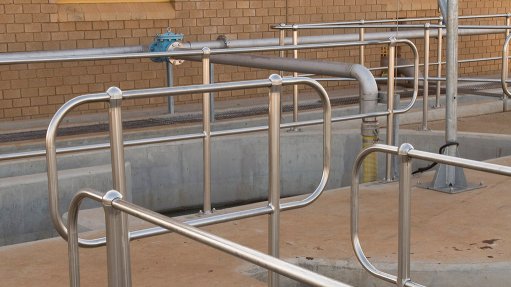
Recognised and accepted as the handrailing of choice in corrosive applications, Andrew Mentis’ stainless steel handrailing system has clean, modern lines that belie its resistance to hostile environments.
Lance Quinlan, marketing manager for Andrew Mentis, says that not only is the use of stainless steel in applications such as wastewater treatment plants a safe and cost effective option, but it does not compromise the aesthetics of the environment.
“In industries such as this, the combination of chemicals and water provide the perfect breeding ground for structural damage through corrosion. These plants, as well as petrochemical operations, require the highest possible protection against this,” he says.
“Corrosion of a handrailing system will compromise the safety of all personnel on a plant. Apart from the costs associated through unscheduled downtime, serious injuries could result from slips and falls due to weakened support.”
Stainless steel stanchions are supplied in a range of standard angles with accessories to match facilitating versatility with different bends and closers available. Manufactured from 304 stainless steel, the stanchion tube has a 45 mm outside diameter (OD) and a 1.6 mm wall thickness.
This provides improved strength and structural integrity ensuring that the stanchion is able to withstand the load factor from the horizontal hand and knee rails. The handrail tubing and bends are 31,8 mm with a 1,5 mm wall thickness.
The components of the handrailing system are manufactured to facilitate ease of installation. The stanchions and bends are part of a system of interlinking components can be installed without the need for special tools.
The centre hole for the knee rail is drilled and then flared on both sides. The top is also flared and a half round cap is welded into place. The base plate is 8 mm thick and welded to the tube. Bends and closures have swaged ends, allowing faster installation and preventing moisture from entering the joints.
Quinlan says that in addition to the stainless steel handrailing system, Andrew Mentis also supplies its Rectagrid RS40 floor grating in 3CR12 for mildly corrosive environments and in 304 for highly corrosive applications as this material contains a higher nickel content ensuring optimum integrity.
Manufactured using a pressure locking system pioneered by the company, Mentis Rectagrid RS40 is known to have the highest load bearing capacity.
During the manufacturing process, the round transversals are permanently locked to the bearer bars enabling the use of the full depth of the bearer bars when calculating loads. This guarantees the structural integrity of the product and further enhances its reliability and longevity in corrosive environments.
“Andrew Mentis’ stainless steel handrailing systems and floor grating are engineered and manufactured to improve safety and reduce maintenance,” Quinlan concludes.
All products are produced in Andrew Mentis’ ISO 9001:2008 accredited facility and independent tests conducted verified the loading bearing capacity of all products.